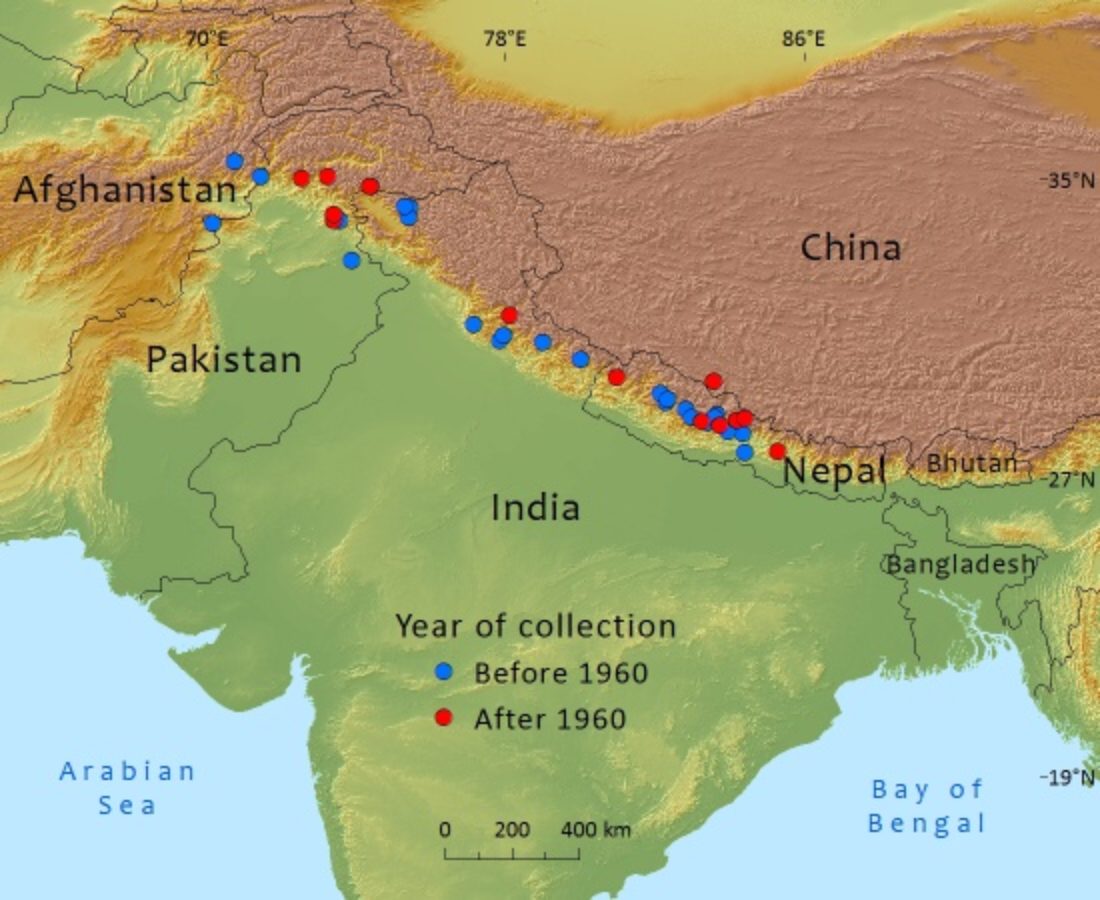Taxaceae
Taxus contorta
Taxus contorta is distributed from Afghanistan through the Himalayas to central Nepal where it is declining due to logging, agricultural expansion and especially exploitation for traditional and modern medicines.
Human Uses
Its timber is used for house construction (roof shingles especially) and furniture as well as more specialised uses such as grave coverings and beehives. In Pakistan especially, the timber is also valued as fuel. In many areas, the foliage is a valuable source of fodder for livestock in winter and early spring. Bark, leaves and twigs have a range of traditional medicinal uses and are also used for the commercial production of Taxol, an anti-cancer drug.
References and further reading
- Ahmed, E., Arshad, M., Ahmad, M., Saeed, M. & Ishaque, M. (2004). Ethnopharmacological survey of some medicinally important plants of Galliyat areas of NWFP, Pakistan. Asian Journal of Plant Sciences 3(4): 410-415.
- Bhattari, N.K. & Karki, M.B. (2004). Conservation and management of Himalayan medicinal plants in Nepal. E.M. Donoghue, G.L. Benson, J.L. Chamberlain, tech. coords. 2004. Sustainable production of wood and non-wood forest products: Proceedings of IUFRO Division 5 Research Groups 5.11 and 5.12, Rotorua, New Zealand, March 11–15, 2003. General Technical Report PNW-GTR-604. Portland. Portland, Oregon: U.S. Department of Agriculture, Forest Service, Pacific Northwest Research Station.: 45-50.
- Dhungana, S.P. & Bhattarai, R.M. (2009). Exploring Economic and Market Dimensions of Forestry Sector in Nepal. Journal of Forest and Livelihood 7(1): 58-69.
- Freitag, H. (1972). Naturliche Vegetation Afghanistans. Vegetatio 22: 285-342.
- Haq, F.U. (2011). Conservation status of the critically endangered species in the Nandiar Khuwar catchment district Battagram, Pakistan. International Journal of Biodiversity and Conservation 3(2): 27-35
- Hussain, M., Shah, G.M. & Khan, M.A. (2006). Traditional medicinal and economic uses of Gymnosperms of Kaghan Valley, Pakistan. Ethnobotanical Leaflets 10: 72-81.
- Mohapatra, K.P., Sehgal, R.N., Sharma, R.K. & Mohapatra, T. (2009). Genetic analysis and conservation of endangered medicinal tree species Taxus wallichiana in the Himalayan region. New Forests 37: 109-121.
- Moller, M.M., Gao, L.M., Mill, R.R., Li, D.Z., Hollingsworth, M.L. & Gibby, M. (2007). Morphometric analysis of the Taxus wallichiana-complex based on herbarium material. Botanical Journal of the Linnaean Society 155: 307-355.
- Mulliken, T. & Crofton, P. (2008). Review of the Status, Harvest, Trade and Management of Seven Asian CITES-listed Medicinal and Aromatic Plant Species. Results of the R+D Project FKZ 804 86 003. Bundesamt für Naturschutz (BfN), Bonn.
- Nasri, I., Delobel, T. & Braud, J. (1995). The conifer forests of the Hindu Kush in eastern Afghanistan: the challenge of their conservation. In: I. ud Din (ed.), Proceedings of the third International Hindu Kush Cultural Conference, pp. 43-52. Chitral town, 26-30 August, 1995.
- Schickoff, U. (1996). Contributions to the synecology and syntaxonomy of West Himalayan coniferous forest communities. Phytocoenologia 26: 537-581.
- Shafique, C.M., Barkati, S. & Rizvi, A. (2008). Study of environmental variables in the moist-temperate environs of western Himalayan mountain range, Pakistan. Records Zoological Survey of Pakistan 18(53-60).
- Shah, A., Li, D.-Z., Moller, M., Gao, L.-M., Hollingsworth, M. & Gibby, M. (2008). Delimitation of Taxus fuana Nan Li & R.R. Mill (Taxaceae) based on morphological and molecular data. Taxon 57(1): 211-222.
- Thomas, P. (2011). A review of the distribution and conservation status of Taxus in the Himalayas, China and Southeast Asia. Spanish Journal of Rural Studies 2(2 (special edition)): 35-42.
- Thomas, P. (2011). Taxus contorta. In: IUCN 2012. IUCN Red List of Threatened Species. Version 2012.2. . Downloaded on 20 March 2013.
- United Nations Environment Programme. (2003). Afghanistan: post conflict environmental assessment. United Nations Environment Programme, Geneva, Switzerland.
- Ved, D.K., Kinhal, G.A., Ravikumar, K., Prabhakaram, V., Ghate, U., Sanka, R.V. & Indresha, J.H. (2003). Conservation assessment and management prioritisation for the medicinal plants of Himachal Pradesh, Jammu and Kashmir and Uttaranchal. Proceedings of the workshop held at Shimla, 19th-24th May 2003.. Shimla.
- Wang, S. & Xie, Y. (2004). China Species Red List. Vol. 1 Red List. Higher Education Press, Beijing, China.
